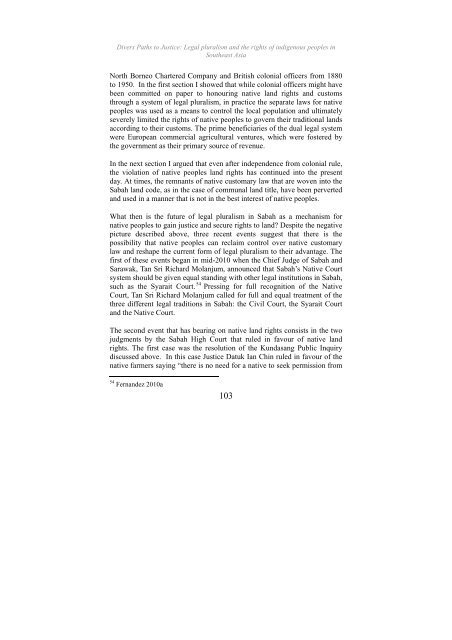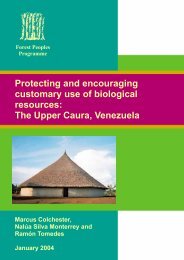Divers Paths to Justice - English - Forest Peoples Programme
Divers Paths to Justice - English - Forest Peoples Programme
Divers Paths to Justice - English - Forest Peoples Programme
Create successful ePaper yourself
Turn your PDF publications into a flip-book with our unique Google optimized e-Paper software.
<strong>Divers</strong> <strong>Paths</strong> <strong>to</strong> <strong>Justice</strong>: Legal pluralism and the rights of indigenous peoples inSoutheast AsiaNorth Borneo Chartered Company and British colonial officers from 1880<strong>to</strong> 1950. In the first section I showed that while colonial officers might havebeen committed on paper <strong>to</strong> honouring native land rights and cus<strong>to</strong>msthrough a system of legal pluralism, in practice the separate laws for nativepeoples was used as a means <strong>to</strong> control the local population and ultimatelyseverely limited the rights of native peoples <strong>to</strong> govern their traditional landsaccording <strong>to</strong> their cus<strong>to</strong>ms. The prime beneficiaries of the dual legal systemwere European commercial agricultural ventures, which were fostered bythe government as their primary source of revenue.In the next section I argued that even after independence from colonial rule,the violation of native peoples land rights has continued in<strong>to</strong> the presentday. At times, the remnants of native cus<strong>to</strong>mary law that are woven in<strong>to</strong> theSabah land code, as in the case of communal land title, have been pervertedand used in a manner that is not in the best interest of native peoples.What then is the future of legal pluralism in Sabah as a mechanism fornative peoples <strong>to</strong> gain justice and secure rights <strong>to</strong> land? Despite the negativepicture described above, three recent events suggest that there is thepossibility that native peoples can reclaim control over native cus<strong>to</strong>marylaw and reshape the current form of legal pluralism <strong>to</strong> their advantage. Thefirst of these events began in mid-2010 when the Chief Judge of Sabah andSarawak, Tan Sri Richard Molanjum, announced that Sabah’s Native Courtsystem should be given equal standing with other legal institutions in Sabah,such as the Syarait Court. 54 Pressing for full recognition of the NativeCourt, Tan Sri Richard Molanjum called for full and equal treatment of thethree different legal traditions in Sabah: the Civil Court, the Syarait Courtand the Native Court.The second event that has bearing on native land rights consists in the twojudgments by the Sabah High Court that ruled in favour of native landrights. The first case was the resolution of the Kundasang Public Inquirydiscussed above. In this case <strong>Justice</strong> Datuk Ian Chin ruled in favour of thenative farmers saying “there is no need for a native <strong>to</strong> seek permission from54 Fernandez 2010a103
















